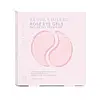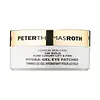What's inside
What's inside
 Key Ingredients
Key Ingredients

 Benefits
Benefits

 Concerns
Concerns

 Ingredients Side-by-side
Ingredients Side-by-side

Water
Skin ConditioningGlycerin
HumectantDipropylene Glycol
Humectant1,2-Hexanediol
Skin ConditioningCeratonia Siliqua Gum
EmollientChondrus Crispus Powder
AbrasiveBetaine
HumectantChondrus Crispus Extract
Skin ConditioningPotassium Chloride
Sucrose
HumectantNiacinamide
SmoothingCitrus Aurantium Dulcis Fruit Extract
MaskingGardenia Florida Fruit Extract
Skin ConditioningCamellia Sinensis Leaf Extract
AntimicrobialMorus Nigra Fruit Extract
Skin ConditioningHydrolyzed Gardenia Florida Extract
AntioxidantResveratrol
AntioxidantAscorbic Acid
AntioxidantCitric Acid
BufferingCellulose Gum
Emulsion StabilisingPhenoxyethanol
PreservativeAlgin
MaskingDextrin
AbsorbentButylene Glycol
HumectantDisodium EDTA
Polysorbate 20
EmulsifyingEthylhexylglycerin
Skin ConditioningMaltodextrin
AbsorbentSodium Polyacrylate
AbsorbentAcacia Senegal Gum
MaskingPeat Water
Skin ConditioningHydroxypropyl Methylcellulose
Emulsion StabilisingPotassium Sorbate
PreservativeParfum
MaskingLimonene
PerfumingHyaluronic Acid
HumectantFragaria Ananassa Fruit Extract
Skin ConditioningWater, Glycerin, Dipropylene Glycol, 1,2-Hexanediol, Ceratonia Siliqua Gum, Chondrus Crispus Powder, Betaine, Chondrus Crispus Extract, Potassium Chloride, Sucrose, Niacinamide, Citrus Aurantium Dulcis Fruit Extract, Gardenia Florida Fruit Extract, Camellia Sinensis Leaf Extract, Morus Nigra Fruit Extract, Hydrolyzed Gardenia Florida Extract, Resveratrol, Ascorbic Acid, Citric Acid, Cellulose Gum, Phenoxyethanol, Algin, Dextrin, Butylene Glycol, Disodium EDTA, Polysorbate 20, Ethylhexylglycerin, Maltodextrin, Sodium Polyacrylate, Acacia Senegal Gum, Peat Water, Hydroxypropyl Methylcellulose, Potassium Sorbate, Parfum, Limonene, Hyaluronic Acid, Fragaria Ananassa Fruit Extract
Water
Skin ConditioningGlycerin
HumectantCarrageenan
Butylene Glycol
HumectantCeratonia Siliqua Gum
EmollientColloidal Gold
AntimicrobialSodium Hyaluronate
HumectantHydrolyzed Collagen
EmollientCaffeine
Skin ConditioningNiacinamide
SmoothingAloe Barbadensis Leaf Juice Powder
Skin ConditioningTocopheryl Acetate
AntioxidantAllantoin
Skin ConditioningJania Rubens Extract
Skin ConditioningAdenosine
Skin ConditioningLavandula Angustifolia Oil
MaskingRicinus Communis Seed Oil
MaskingCalcium Lactate
AstringentXanthan Gum
EmulsifyingDisodium EDTA
PEG-60 Hydrogenated Castor Oil
EmulsifyingSynthetic Fluorphlogopite
Mica
Cosmetic ColorantTin Oxide
AbrasiveChlorphenesin
AntimicrobialPhenoxyethanol
PreservativeCI 77480
Cosmetic ColorantCI 77491
Cosmetic ColorantCI 77891
Cosmetic ColorantWater, Glycerin, Carrageenan, Butylene Glycol, Ceratonia Siliqua Gum, Colloidal Gold, Sodium Hyaluronate, Hydrolyzed Collagen, Caffeine, Niacinamide, Aloe Barbadensis Leaf Juice Powder, Tocopheryl Acetate, Allantoin, Jania Rubens Extract, Adenosine, Lavandula Angustifolia Oil, Ricinus Communis Seed Oil, Calcium Lactate, Xanthan Gum, Disodium EDTA, PEG-60 Hydrogenated Castor Oil, Synthetic Fluorphlogopite, Mica, Tin Oxide, Chlorphenesin, Phenoxyethanol, CI 77480, CI 77491, CI 77891
Ingredients Explained
These ingredients are found in both products.
Ingredients higher up in an ingredient list are typically present in a larger amount.
Butylene Glycol (or BG) is used within cosmetic products for a few different reasons:
Overall, Butylene Glycol is a safe and well-rounded ingredient that works well with other ingredients.
Though this ingredient works well with most skin types, some people with sensitive skin may experience a reaction such as allergic rashes, closed comedones, or itchiness.
Learn more about Butylene GlycolCeratonia Siliqua Gum is extracted from the seeds of the carob tree. You might know this ingredient as Carob Gum or Locust Bean Gum. It is used to stabilize other ingredients and improve the texture of products.
Carob gum is made up of long-chain polysaccharides. This makes it a natural thickener.
Yes! This ingredient comes from the seeds of a tree. The name 'Locust Bean Gum' can be misleading.
Learn more about Ceratonia Siliqua GumDisodium EDTA plays a role in making products more stable by aiding other preservatives.
It is a chelating agent, meaning it neutralizes metal ions that may be found in a product.
Disodium EDTA is a salt of edetic acid and is found to be safe in cosmetic ingredients.
Learn more about Disodium EDTAGlycerin is already naturally found in your skin. It helps moisturize and protect your skin.
A study from 2016 found glycerin to be more effective as a humectant than AHAs and hyaluronic acid.
As a humectant, it helps the skin stay hydrated by pulling moisture to your skin. The low molecular weight of glycerin allows it to pull moisture into the deeper layers of your skin.
Hydrated skin improves your skin barrier; Your skin barrier helps protect against irritants and bacteria.
Glycerin has also been found to have antimicrobial and antiviral properties. Due to these properties, glycerin is often used in wound and burn treatments.
In cosmetics, glycerin is usually derived from plants such as soybean or palm. However, it can also be sourced from animals, such as tallow or animal fat.
This ingredient is organic, colorless, odorless, and non-toxic.
Glycerin is the name for this ingredient in American English. British English uses Glycerol/Glycerine.
Learn more about GlycerinNiacinamide is a multitasking form of vitamin B3 that strengthens the skin barrier, reduces pores and dark spots, regulates oil, and improves signs of aging.
And the best part? It's gentle and well-tolerated by most skin types, including sensitive and reactive skin.
You might have heard of "niacin flush", or the reddening of skin that causes itchiness. Niacinamide has not been found to cause this.
In very rare cases, some individuals may not be able to tolerate niacinamide at all or experience an allergic reaction to it.
If you are experiencing flaking, irritation, and dryness with this ingredient, be sure to double check all your products as this ingredient can be found in all categories of skincare.
When incorporating niacinamide into your routine, look out for concentration amounts. Typically, 5% niacinamide provides benefits such as fading dark spots. However, if you have sensitive skin, it is better to begin with a smaller concentration.
When you apply niacinamide to your skin, your body converts it into nicotinamide adenine dinucleotide (NAD). NAD is an essential coenzyme that is already found in your cells as "fuel" and powers countless biological processes.
In your skin, NAD helps repair cell damage, produce new healthy cells, support collagen production, strengthen the skin barrier, and fight environmental stressors (like UV and pollution).
Our natural NAD levels start to decline with age, leading to slower skin repair, visible aging, and a weaker skin barrier. By providing your skin niacinamide, you're recharging your skin's NAD levels. This leads to stronger, healthier, and younger looking skin.
Another name for vitamin B3 is nicotinamide. This vitamin is water-soluble and our bodies don't store it. We obtain Vitamin B3 from either food or skincare. Meat, fish, wheat, yeast, and leafy greens contain vitamin B3.
The type of niacinamide used in skincare is synthetically created.
Learn more about NiacinamidePhenoxyethanol is a preservative that has germicide, antimicrobial, and aromatic properties. Studies show that phenoxyethanol can prevent microbial growth. By itself, it has a scent that is similar to that of a rose.
It's often used in formulations along with Caprylyl Glycol to preserve the shelf life of products.
Water. It's the most common cosmetic ingredient of all. You'll usually see it at the top of ingredient lists, meaning that it makes up the largest part of the product.
So why is it so popular? Water most often acts as a solvent - this means that it helps dissolve other ingredients into the formulation.
You'll also recognize water as that liquid we all need to stay alive. If you see this, drink a glass of water. Stay hydrated!
Learn more about Water